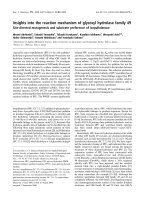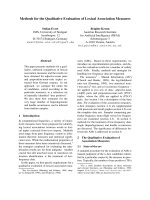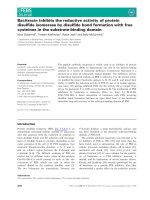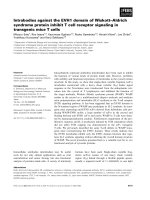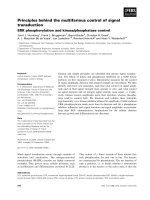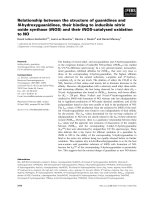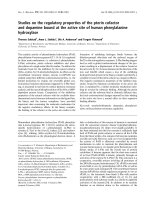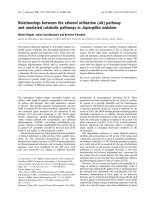Báo cáo khoa học: " Associations between the clinical signs of chronic endometritis with ovarian cysts and body condition loss in German Holstein Friesian cows" docx
Bạn đang xem bản rút gọn của tài liệu. Xem và tải ngay bản đầy đủ của tài liệu tại đây (242.57 KB, 5 trang )
JOURNAL OF
Veterinary
Science
J. Vet. Sci. (2009), 10(4), 337
341
DOI: 10.4142/jvs.2009.10.4.337
*Corresponding author
Tel: +30-2310-994466; Fax: +30-2310-994452
E-mail:
Associations between the clinical signs of chronic endometritis with
ovarian cysts and body condition loss in German Holstein Friesian cows
Georgios Tsousis
1,
*
, Reza Sharifi
2
, Martina Hoedemaker
3
1
Clinic of Farm Animals, Faculty of Veterinary Medicine, Aristotle University of Thessaloniki, St. Voutyra str. 11, 54627,
Greece
2
Institute of Animal Breeding and Genetics, University of Göttingen, Albrecht-Thaer-Weg 3, 37075, Germany
3
Clinic for Cattle, University of Veterinary Medicine Hanover, Bischofsholer Damm 15, 30173, Germany
The objective of this retrospective field study was to
associate the type and smell of discharge, the size of the
uterus, the ovarian and treatment status, and the time to
diagnosis of animals with chronic clinical endometritis
(CCE) with the incidence of ovarian cysts and with a
marked loss in body condition in German Holstein Friesian
cows. Two hundred and sixty-four cows diagnosed with
CCE from day 14 to day 42 postpartum participated in
this study. In addition, 100 days milk production and the
parity of the animals were included in the analysis. With
the use of logistic regression, a purulent vaginal discharge
(
≥
50% pus), the decision not to treat the animals for
CCE and a high 100 days milk production proved to be
significant factors for the incidence of ovarian cysts.
Additionally, the type of discharge showed interactions
with the parity and the smell of the discharge, as more
animals with fetid and purulent discharge and more
animals in the first lactation with a purulent discharge
developed ovarian cysts. A high milk production and the
parity showed associations with an excessive body condition
score loss. Additionally, more animals with a diagnosis of
an oversized uterus in comparison to cows with an early
involution experienced a considerable reduction in their
nutritional condition.
Keywords:
body condition score, endometritis, ovarian cysts
Introduction
Uterine disease of dairy cattle postpartum (p.p.) influences
reproductive performance and causes important financial
losses [1,14,18]. There is growing evidence that not all of
the clinical signs of chronic clinical endometritis (CCE)
have the same effect on the reproductive parameters used
in farms. For instance, LeBlanc et al. [16] found that only
a purulent vaginal discharge or a diameter of the cervix
larger than 7.5 cm had prognostic value for the diagnosis of
endometritis and when vaginoscopy was applied, no
diagnostic criteria based on palpation of the uterus had a
predictive value for the time to pregnancy. Moreover,
Williams et al. [32] concluded that the evaluation of the
type and smell of vaginal discharge reflects the number of
bacteria in the uterus. Clinical endometritis does not only
have a direct effect on reproductive performance, but also
seems to be associated with ovarian dysfunctions [26,31],
and/or reduction of the body condition of dairy cattle [27],
which in turn suppress fertility. Additionally, the effect of
CCE treatment on the main fertility measures has been
found to be modest [10,17].
The present study aimed to investigate if there are any
associations between the clinical signs and CCE treatment
with the incidence of ovarian cysts and with the reduction
of the body condition score p.p. of dairy cows.
Materials and Methods
The details of the study herds and the examination
protocols have been previously reported [29]. Briefly, data
from seven dairy herds were gathered and evaluated. Two
experienced and similarly trained veterinarians carried out
all the examinations following the diagnosis and treatment.
Starting from day 14 p.p. and up to day 42 p.p., all animals
without peripartum problems were examined with transrectal
palpation to monitor uterine involution and uterine
anatomical characteristics. Deviation from the reference
values for contractility and/or content of the uterus (i.e.
uterus to be gathered in the hand and without fluctuation)
resulted in an examination with vaginal speculum. Mean
time of diagnosis was 21 ± 8 days p.p. Additionally, all
animals with peripartum problems (e.g. retentio secundinarum,
dystocia, fetal death, early birth, birth of twins, torsio uteri
338 Georgios Tsousis et al.
or abortion) were examined routinely via vaginal
inspection. The animals were re-examined at 14 or 28 days
intervals depending on the farm’s management program
and until pregnancy was confirmed, the cow was culled, or
until the farmer expressed his decision not to breed the
animal again.
Inclusion criteria were abnormal vaginal discharge (i.e.
containing pus), no systemic disorder of the animal until
day 42 p.p., and no additional genital diseases with the
exception of ovarian cysts (OC) until pregnancy or the
decision to cull. At the time of diagnosis, the following
clinical characteristics were categorized:
ㆍType of discharge (TYPEDIS): Purulent (≥ 50% pus)
or mucopurulent with flakes of pus (< 50% pus)
ㆍSmell of discharge (SMELL): Fetid or neutral smell
ㆍSize of uterus (USIZE): Uterus that could be held in the
hand (normal involution) or not (oversized)
ㆍTime of diagnosis (TIMED): ≤ 21 or > 21 days p.p.
ㆍPresence or absence of a corpus luteum at the time of
diagnosis (CL).
Two hundred and sixty-four Holstein Friesian cows with
CCE were eligible for this study. The animals remained
untreated (n = 166) or received treatment (n = 98) (TREAT)
using routine medication, either locally (antibiotics, n =
17; disinfectants, n = 2), systemically (analogs of
prostaglandin-F2-alpha, PGF
2α
, n = 59) or with a
combination of these treatments (n = 20). The animals
were classified into two parity (PARITY) groups: those of
the first lactation and those past first lactation. OC were
diagnosed by means of transrectal palpation as follicular
structures with a diameter of at least 25 mm interfering
with normal ovarian activity, which was proved in the next
follow up examination. Although transrectal examinations
were supported by an ultrasound device equipped with a 5
MHz transducer, no attempt was made in this study to
classify into different types of OC in order to achieve
adequate statistical power. The examination period extended
from day 21 p.p. until the animal was diagnosed as pregnant
or was culled.
Body condition score (BCS) of all animals was conducted
at least once monthly throughout the lactation following
the chart of Edmondson et al. [11]. Changes in BCS
(ΔBCS) were derived from the first p.p. estimation and the
lowest value before successful artificial insemination (a.i.)
or culling. A ΔBCS greater or equal to one point was
considered excessive. The 100 days milk production
(ML100) value was derived for each animal with using
Wood’s lactation curves [33]. The animals were then
divided into two groups according to their milk production:
Those producing less than and those producing more than
3,824 kg in the first 100 days of lactation under
investigation. This limit was defined by using a linear
regression function between 100 days and 305 days milk
production and setting as a limit 10,000 kg of milk
production in the equation. Nine animals were culled
before reaching 100 days of lactation.
Modelling process
Statistical analyses of OC and ΔBCS data were carried out
using a linear logistic model with a binary response
variable, which was modeled as a binomial random
variable (y
i
). The dependent variable (y
i
) can have the value
1 with a probability of obtaining OC or ΔBCS
π
i
or the
value 0 with a probability of healthy 1-
π
i
for observation i.
The logistic model uses a link function g (
μ
i
), linking the
expected value to the linear predictors
η
i
.
The logit link function is defined by log =
η
i
where
π
i
is the probability of occurrence recorded from day 21
p.p. and until the date of successful a.i. or culling.
The data were then analyzed with the SAS GLIMMIX
macro, a generalized linear model, including fixed effects
of TYPEDIS, SMELL, USIZE, TIMED, CL, TREAT,
PARITY and ML100. All two-way interactions between
the clinical characteristics, parity and treatment were
tested and only significant effects among the different
effects were included in the final model used for analysis.
Least square means were estimated on the logit scale and
then back-transformed using the inverse link function
π =
e
χ
p (
χ
β
)/ [1+e
χ
p (
χ
β
)] to the original scale (probability) by
applying the LSMEANS statement. Significant differences
between least square means were tested using a t-test
procedure by including the PDIFF option in the LSMEANS
statement. Standard errors of least square means were
calculated as described by Littell et al. [21]. The data were
analyzed using the following generalized linear model:
log =
ϕ +
D
i
+ S
j
+T
κ
+
P
l
+ U
m
+ CP
n
+ML
o
+ TD
p
+ C
r
where
π
ijklmnop
=
probability of OC,
ϕ
=
overall mean
effect,
D
i
= fixed effect of TYPEDIS, S
j
= fixed effect of
SMELL, T
k
= fixed effect of TREAT, P
l
= fixed effect of
PARITY, U
m
= fixed effect of USIZE, CP
n
= fixed effect of
CL, ML
o
= fixed effect of ML100, TD
p
= fixed effect of
TIMED, C
r
= random effect of farm.
A similar model was fit for the variable ΔBCS. Stepwise
forward selection was used and the levels of significance
were 0.50 to enter the model and < 0.1 to remain in it. All
analyses and graphic functions were conducted using SAS
version 8 (SAS Institute, USA).
Results
The incidence of ovarian cysts (Table 1) proved to be
substantially higher in animals not receiving any treatment
π
i
1-
π
i
π
ijklmnop
1-
π
ijklmnop
Associations of endometritis with ovarian cysts and body condition score loss 339
Tab l e 1 . F-Values, levels of significance,and least squares means
of the variables remaining in the logistic model for the incidence
of ovarian cysts in Holstein Friesian cattle diagnosed with
chronic clinical endometritis (CCE)
Variable Stratum n Incidence F-value
p
-value
Corpus
luteum
Absence 91 13.4 ± 5.2
a
3.47 0.06
Presence 155 6.1 ± 2.8
a
100 days
milk yield
> 3,824 kg 59 18.7 ± 5.2
a
11.46 0.0008
≤ 3,824 kg 196 4.2 ± 1.8
b
Parity
1 97 6.8 ± 4.1
a
0.93 0.34
> 1 167 12.2 ± 3.7
a
Smell
Fetid 88 8.0 ± 3.9
a
0.27 0.60
N
eutral 172 10.4 ± 3.9
a
Treatment
Yes 9 8 4 . 3 ± 2 . 7
a
7.52 0.007
N
o 166 18.2 ± 5.2
b
Type of
discharge
Purulent 107 19.4 ± 5.6
a
5.97 0.02
Mucopurulent 151 4.0 ± 2.6
b
Smell by
type of
discharge
Fetid & purulent 54 27.5 ± 9.2
a
4.35 0.04
Fetid &
mucopurulent
33 2.0 ± 1.8
b
N
eutral & purulent 54 13.3 ± 5.9
a,b
N
eutral &
mucopurulent
117 8.0 ± 4.4
b
Parity by
type of
discharge
> 1 Lactation
& purulent
73 14.0 ± 5.0
a
5.38 0.02
> 1 Lactation
& mucopurulen
t
89 10.7 ± 4.8
a,b
1 Lactation
& purulent
35 26.4 ± 10.8
a
1 Lactation
& mucopurulent
61 1.5 ± 1.6
b
a,b
Least squares means within variable with different superscript
differ significantly (p ≤ 0.05)
Tabl e 2 . F-Values, levels of significance,and least squares means
of the variables remaining in the logistic model for the incidence
of a reduction ≥ 1.0 on a five-point scale body condition score
loss in Holstein Friesian cattle diagnosed with CCE
Variable Stratum n Incidence F-value
p
-value
100 days
milk yield
> 3,824 kg 59 30.3 ± 8.0
a
4.78 0.03
≤ 3,824 kg 196 16.5 ± 3.5
b
Parity
1 97 12.1 ± 5.0
a
9.80 0.002
> 1 167 38.3 ± 4.7
b
Size of
uterus
Oversized 64 29.6 ± 7.9
a
3.74 0.05
Involution 197 16.9 ± 3.7
a
a,b
Least squares means within variable with different superscript
differ significantly (p ≤ 0.05).
for CCE (p = 0.007), having a purulent vaginal discharge
(p = 0.02) and having a ML100 of more than 3,824 kg (p =
0.001). For OC, the SMELL by TYPEDIS and the
PARITY by TYPEDIS interactions were important with
p-values of 0.04 and 0.02, respectively. Namely, 27% of
the animals with purulent and fetid discharge and 13% with
purulent but not fetid discharge developed OC, whereas in
animals with mucopurulent discharge, this percentage was
below 10% (Table 1). Additionally, a purulent discharge
seemed to have a detrimental effect especially in cows in
the first lactation, as 26% developed OC in comparison to
only 1.5% when the discharge was mucopurulent. Older
cows developed OC in 14% and 11% of the cases when the
discharge was purulent and mucopurulent, respectively.
In the high milk yield group, a higher proportion of
animals revealed a marked BCS loss compared with lower
producing cows (p = 0.03, Table 2). Parity also had a
significant effect, as almost 40% of the older cows
experienced a severe body condition loss in comparison to
only 12% of the animals in first lactation (p = 0.002).
Additionally, more cows diagnosed with an oversized
uterus experienced a considerable reduction in their
nutritional condition compared to cows with an early
involution, although this result was slightly over the
significance level of 0.05 (p = 0.054). For ΔBCS no
interaction between variables proved to be significant.
Discussion
There is evidence that intrauterine infections are involved
in the pathogenesis of ovarian dysfunctions [8,22,23,31],
probably by disrupting the normal function of the hypothalamus-
pituitary-ovarian axis due to endotoxins [26]. In the
present study, a purulent vaginal discharge also proved to
enhance the risk of ovarian cysts compared to a mucopurulent
one. A similar finding was also reported by Mateus et al.
[23]. First-time calvers seemed to be especially affected by
a purulent discharge, which could be a result of a higher
frequency of assisted calvings and the resulting uterine
lesions noticed in this group of animals [3]. Other authors
also hypothesize that uterine trauma could be a prerequisite
for the association between uterine infection and ovarian
dysfunction [24]. Furthermore, a purulent discharge is
associated with the presence of Arcanobacterium pyogenes
[32], which is the microorganism with the strongest proof
of causing uterine lesions [6].
340 Georgios Tsousis et al.
On the other hand, the effect of vaginal discharge odour
on reproductive performance, which is used under practical
conditions quite often as a measure of the severity of CCE,
has rarely been evaluated separately. Williams et al. [32]
found that a fetid odour was associated with the presence of
A. pyogenes and Escherichia coli, but not with that of
Fusobacterium necrophorum or Prevotella melaninogenicus,
the synergy of which is important for the pathogenesis of
CCE in dairy cattle [6]. Additionally, a fetid odor was
associated with higher bacterial growth densities of
streptococci [32], which seem to have antagonistic effects
on A. pyogenes [6,9]. Nevertheless, a synergic association
of fetid odor and purulent discharge was significant for the
incidence of ovarian cysts in this study.
It was also found that more animals with an oversized
uterus demonstrated a remarkable decline in their body
condition, probably resembling a situation where an
afflicted organism has difficulties in coping with normal
biological processes (e.g. uterine involution). Whether a
nonsystemic illness further impairs the food consumption
and consequently the decline in body condition, as
proposed by Bell and Roberts [3], or whether a negative
energy balance, which is associated with puerperal metritis
[13], conflicts with the reestablishment of the genital tract
to its pregravid characteristics remains to be answered by
prospective research projects. In agreement with other
studies [19], older cows lost more body condition than
younger ones, probably because of the increase in the milk
production.
The importance of a relatively early resumption of
cyclicity as a predictor for good reproductive ability has
often been emphasized [7,16]. Nevertheless, other authors
suggest that an early luteal activity and consequently an
early increase in the progesterone levels could result in an
increased susceptibility to uterine infections [20] or in a
prolonged calving to conception interval [28]. In this study,
a prompt resumption of cyclicity showed a weak negative
association with the development of ovarian cysts. The
exact mechanism of this effect is not known. However, it
could be a consequence of the uterine contractions during
estrus resulting in the reduction of the bacterial load, as
proposed by LeBlanc et al. [17]. On the other hand, the
return to cyclicity could also be indicative of a healthy
endometrium, as it is found that infected animals ovulate
significantly later compared to healthy ones [25].
The impact of high milk production is a matter of
controversy among researchers. An antagonistic genetic
[12,30] and phenotypic [2] relationship with the reproductive
measures have been reported and are generally accepted. In
the present study, an association of high milk production
with the occurrence of ovarian cysts and the decrease in the
body condition was noticed. These findings have also been
found by other authors [4,22].
Our results do suggest an association between CCE
treatment with the formation of ovarian cysts. Bonnett et
al. [5] found that a prostaglandin administration on day 26
p.p. resulted in less inflammation and fibrosis of the
endometrium by day 40. Furthermore, Königsson et al.
[15] found that cows recovered faster from A. pyogenes
and F. necrophorum infections with the intrauterine
application of antibiotics. A better functionality of the
endometrium and a reduction in the endotoxin stress
caused by the endometritis could be the explanation for the
clinical results in this study.
In conclusion, we have found associations between the
clinical signs of chronic endometritis and the incidence of
ovarian cysts. In addition, a positive effect of CCE
treatment on OC was also determined. Based on our results,
animals showing a purulent discharge, a combination of
purulent discharge accompanied with a fetid odor, and the
first lactation cows with purulent discharge require
particular veterinary attention in order to minimize the
risks of ovarian cysts.
References
1. Azawi OI. Postpartum uterine infection in cattle. Anim
Reprod Sci 2008, 105, 187-208.
2. Bagnato A, Oltenacu PA. Phenotypic evaluation of fertility
traits and their association with milk production of Italian
Friesian cattle. J Dairy Sci 1994, 77, 874-882.
3. Bell MJ, Roberts DJ. The impact of uterine infection on a
dairy cow's performance. Theriogenology 2007, 68, 1074-
1079.
4. Berry DP, Buckley F, Dillon P, Evans RD, Rath M,
Veerkamp RF. Genetic relationships among body condition
score, body weight, milk yield, and fertility in dairy cows. J
Dairy Sci 2003, 86, 2193-2204.
5. Bonnett BN, Etherington WG, Martin SW, Johnson
WH. The effect of prostaglandin administration to Holstein-
Friesian cows at Day 26 postpartum on clinical findings, and
histological and bacteriological results of endometrial
biopsies at Day 40. Theriogenology 1990, 33, 877-890.
6. Bonnett BN, Martin SW, Gannon VP, Miller RB,
Etherington WG. Endometrial biopsy in Holstein-Friesian
dairy cows. III. Bacteriological analysis and correlations
with histological findings. Can J Vet Res 1991, 55, 168-173.
7. Bonnett BN, Martin SW, Meek AH. Associations of
clinical findings, bacteriological and histological results of
endometrial biopsy with reproductive performance of
postpartum dairy cows. Prev Vet Med 1993, 15, 205-220.
8. Bosu WT, Peter AT. Evidence for a role of intrauterine
infections in the pathogenesis of cystic ovaries in postpartum
dairy cows. Theriogenology 1987, 28, 725-736.
9. Dohmen MJW, Lohuis JACM, Huszenicza G, Nagy P,
Gacs M. The relationship between bacteriological and
clinical findings in cows with subacute chronic endometritis.
Theriogenology 1995, 43, 1379-1388.
10. Dolezel R, Vecera M, Palenik T, Cech S, Vyskocil M.
Systematic clinical examination of early postpartum cows
Associations of endometritis with ovarian cysts and body condition score loss 341
and treatment of puerperal metritis did not have any
beneficial effect on subsequent reproductive performance.
Vet Med 2008, 53, 59-69.
11. Edmonson AJ, Lean IJ, Weaver LD, Farver T, Webster
G. A body condition scoring chart for Holstein dairy cows. J
Dairy Sci 1989, 72, 68-78.
12. Gonz
á
lez-Recio O, Alenda R, Chang YM, Weigel KA,
Gianola D. Selection for female fertility using censored
fertility traits and investigation of the relationship with milk
production. J Dairy Sci 2006, 89, 4438-4444.
13. Huzzey JM, Veira DM, Weary DM, von Keyserlingk
MAG. Prepartum behavior and dry matter intake identify
dairy cows at risk for metritis. J Dairy Sci 2007, 90,
3220-3233.
14. Kim IH. Risk factors for delayed conception in Korean dairy
herds. J Vet Sci 2006, 7, 381-385.
15. K
önigsson K, Gustafsson H, Gunnarsson A, Kindahl H.
Clinical and bacteriological aspects on the use of oxytetracycline
and flunixin in primiparous cows with induced retained
placenta and post-partal endometritis. Reprod Domest Anim
2001, 36, 247-256.
16. LeBlanc SJ, Duffield TF, Leslie KE, Bateman KG, Keefe
GP, Walton JS, Johnson WH. Defining and diagnosing
postpartum clinical endometritis and its impact on
reproductive performance in dairy cows. J Dairy Sci 2002,
85, 2223-2236.
17. LeBlanc SJ, Duffield TF, Leslie KE, Bateman KG, Keefe
GP, Walton JS, Johnson WH. The effect of treatment of
clinical endometritis on reproductive performance in dairy
cows. J Dairy Sci 2002, 85, 2237-2249.
18. LeBlanc SJ, Lissemore KD, Kelton DF, Duffield TF,
Leslie KE. Major advances in disease prevention in dairy
cattle. J Dairy Sci 2006, 89, 1267-1279.
19. Lee JY, Kim IH. Advancing parity is associated with high
milk production at the cost of body condition and increased
periparturient disorders in dairy herds. J Vet Sci 2006, 7,
161-166.
20. Lewis GS. Uterine health and disorders. J Dairy Sci 1997,
80, 984-994.
21. Littell RC, Milliken GA, Stroup WW, Wolfinger RD.
SAS System for Mixed Models. pp. 423-460, SAS Institute,
Cary, 1999.
22. L
ópez-Gatius F, Santolaria P, Yániz J, Fenech M,
L
ópez-Béjar M. Risk factors for postpartum ovarian cysts
and their spontaneous recovery or persistence in lactating
dairy cows. Theriogenology 2002, 58, 1623-1632.
23. Mateus L, da Costa LL, Bernardo F, Silva JR. Influence
of puerperal uterine infection on uterine involution and
postpartum ovarian activity in dairy cows. Reprod Domest
Anim 2002, 37, 31-35.
24. Miller AN, Williams EJ, Sibley K, Herath S, Lane EA,
Fishwick J, Nash DM, Rycroft AN, Dobson H, Bryant
CE, Sheldon IM. The effects of Arcanobacterium pyogenes
on endometrial function in vitro, and on uterine and ovarian
function in vivo. Theriogenology 2007, 68, 972-980.
25. Opsomer G, Gr
öhn YT, Hertl J, Coryn M, Deluyker H,
de Kruif A. Risk factors for post partum ovarian dysfunction
in high producing dairy cows in Belgium: a field study.
Theriogenology 2000, 53, 841-857.
26. Peter AI, Bosu WI. Influence of intrauterine infections and
follicular development on the response to GnRH administration
in postpartum dairy cows. Theriogenology 1988, 29, 1163-
1175.
27. Runciman DJ, Anderson GA, Malmo J, Davis GM. Use
of postpartum vaginoscopic (visual vaginal) examination of
dairy cows for the diagnosis of endometritis and the
association of endrometritis with reduced reproductive
performance. Aust Vet J 2008, 86, 205-213.
28. Smith MCA, Wallace JM. Influence of early post partum
ovulation on the re-establishment of pregnancy in multiparous
and primiparous dairy cattle. Reprod Fertil Dev 1998, 10,
207-216.
29. Tsousis G, Sharifi A, Hoedemaker M. Increased risk of
conception failure in German Holstein Friesian cows with
chronic endometritis. Reprod Domest Anim 2009. Epub
ahead of print. doi:10.1111/j.1439-0531.2009.01481.×.
30. Veerkamp RF, Koenen EPC, De Jong G. Genetic correlations
among body condition score, yield, and fertility in first-
parity cows estimated by random regression models. J Dairy
Sci 2001, 84, 2327-2335.
31. Williams EJ, Fischer DP, Noakes DE, England GC,
Rycroft A, Dobson H, Sheldon IM. The relationship
between uterine pathogen growth density and ovarian
function in the postpartum dairy cow. Theriogenology 2007,
68, 549-559.
32. Williams EJ, Fischer DP, Pfeiffer DU, England GC,
Noakes DE, Dobson H, Sheldon IM. Clinical evaluation of
postpartum vaginal mucus reflects uterine bacterial infection
and the immune response in cattle. Theriogenology 2005, 63,
102-117.
33. Wood PDP. Algebraic model of the lactation curve in cattle.
Nature 1967, 216, 164-165.
